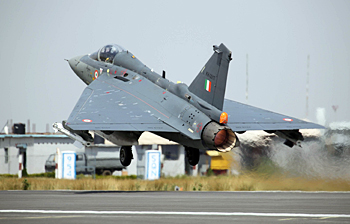- Prime Minister Narendra Modi inaugurates Aero India 2023 in Bengaluru; Releases Commemorative Stamp
- Defence Secretary meets delegations from Saudi Arabia, USA and Oman on the sidelines of Aero India 2023
- Foreign Ministers of 32 countries to attend Aero India 2023
- Embraer showcases the C-390 Millennium at Aero India 2023
India’s Tejas Era Begins

On display here at Aero India 2015, you couldn’t have missed the static display of the LCA Tejas, India’s light fighter. Unlike the LCA that enthralled Prime Minister Narendra Modi at the inaugural flying display yesterday, the Tejas on ground is the first production series fighter in a project that has spanned three decades, crossed thousands of hurdles, and finally produced a sturdy light-weight fighter plane. The specimen you see on the ground was recently handed over to the Indian Air Force, formally beginning the type’s life with its primary customer. But work is far from over. Indeed, in many ways, the real work starts now.
Over the next nine-ten months, the baseline version of the Tejas will gallop through a substantial list of pending test points it is mandatorily required to cross before it obtains final operational clearance, a milestone that declares it officially available for real operations. While there have been whispers that slow progress could push the final date for clearance to mid-2016, the Aeronautical Development Agency (ADA) is firm in its view that they want to wrap things up by 2015, so series production at HAL can kick off in earnest and energies can be rightly focused on the Tejas Mk.2, a modified variant that will fly on the powerful F414- GE-INS6 engine as opposed to the F404 that the Mk.1 flies on.
The dash to the FOC deadline began in December 2013, and it’s been a tough journey. During the next few critical months, the Tejas will be made to demonstrate aerial refuelling from an IAF Il-78M tanker, demonstrate the use of the Gryazev-Shipunov GSh-23 gun in flight, demonstrate a high-speed low drag bomb fitted with a retarding tail assembly, demonstrate drop tanks for the supersonic regime, integrate and fire Israeli Derby and Python beyond visual range missiles. The FOC tests also include enhancing angle of attack and overall flight envelope.
In 2013, ahead of the final test campaign, the LCA Tejas had demonstrated its operational prowess at the Iron Fist fire power demonstration over the Thar Desert, in an effort to see the platform perform alongside other aircraft in IAF inventory. The LCA Tejas fired an R-73 missile and dropped precision guided bombs during the demonstration. Said Air Commodore K.A. Muthana of the National Flight Test Centre (NFTC) on its performance, “The Indian Light Combat aircraft (LCA) was conceived in the early eighties and is now on the threshold of entering squadron service. The legacy of this aircrafts’ development has resulted in true challenges to deployment being faced at a very late stage. There are even insinuations that this aircraft has been more of a success to the scientists in lab coats than to the war fighter in flight suits. True; this fine aircraft has been hostage to a series of systemic shortcomings. There are significant lessons here for the Indian aviation industry. It is vitally important that these lessons are imbibed in order to move forward coherently in building a strong aeronautics industry in this country. Tejas is a wonderful flying machine. It deserved to be in squadron service years ago. Remedial action on many of the shortcomings commented upon, if implemented even now, will favorably impact timelines for IOC and FOC of the Tejas Mk 1 aircraft. Favorable impact on Tejas Mk 2 and other future programs will be enormous.”
And that’s where Aero India 2015 comes in. At the show this year, two things happen for the Tejas that should be of interest to the world. One, it has finally been unveiled as a ready, production series airplane. Customers looking at the Tejas as a light frontline air defence platform or a high-performance lead in jet trainer will now be able to strike up real conversations on possible export deals. With the IAF ordering only 40 odd jets of the Mk.1 baseline version, the field is open for foreign customers to make use HAL’s production line and strength. Second, with work on the Mk.1 largely done, the opportunities for cooperation on the Mk.2 with global firms is now an open field. The Aeronautical Development Agency (ADA) has had a busy year, with marked progress on the LCA Navy too. But, as Air Commodore Muthana notes, the lessons of the Mk.1 are critical to the success of the more important Mk.2, of which the IAF wants 80 odd units. It is the Mk.2 that will be the true Tejas.





